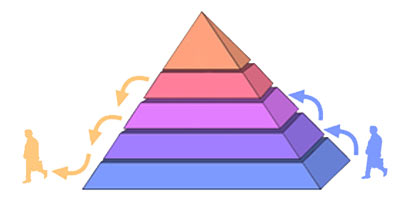
Essential Upgrades: Understanding Dynamic and Static Donor Relationships
 No one works in a non-profit development office very long before being confronted with the pyramid. First-time or occasional gifts at the bottom, regular gifts to the annual fund up a little higher, then major gifts, and finally estate gifts on top. The labels vary from one pyramid to another, but one thing does not change. The goal is always to upgrade donor involvement — that is, to move first-time donors up the pyramid to become regular donors who increase their giving over the years and eventually replace their annual giving with a major gift as a part of their estate plan.
No one works in a non-profit development office very long before being confronted with the pyramid. First-time or occasional gifts at the bottom, regular gifts to the annual fund up a little higher, then major gifts, and finally estate gifts on top. The labels vary from one pyramid to another, but one thing does not change. The goal is always to upgrade donor involvement — that is, to move first-time donors up the pyramid to become regular donors who increase their giving over the years and eventually replace their annual giving with a major gift as a part of their estate plan.
Everyone knows that organizations need to upgrade donor relationships. Increased giving per donor will of course result in more income to the organization. However, you may have already reached the giving capacity of some of your donors. What many organizational leaders fail to understand is that upgrading donor relationships is not just a matter of increasing giving levels; it is a matter of sustaining current donor relationships and contributions.
Static relationships are those that are consistent and unlikely to change. Dynamic relationship are those that are temporary or in a state of continual change.
The Pareto Principle (or 80/20 rule) is commonly applied to non-profit organizations. Twenty percent of donors give eighty percent of the money. That is about the same ratio of static to dynamic donor relationships. Static relationships are those that are consistent and unlikely to change. Dynamic relationship are those that are temporary or in a state of continual change.
There is a small group of your donors who will continue giving in the same manner and at the same level for as long as they live. It is a relatively static relationship, meaning they are not thinking about increasing their involvement, and they probably won’t go away even in difficult times. In a development audit, this group of people would be viewed almost like a fixed asset of the organization.
There is a much larger segment of your donors who have dynamic relationships with organizations. These individuals or corporations are either upgrading or downgrading their relationship and involvement with each organization. Lapsed or inactive donors are simply those who did not upgrade that particular relationship.
You can think of static and dynamic donor involvement in terms of a stereotypical boyfriend-girlfriend relationship. The guy really likes his girlfriend and enjoys hanging out with her. She is cute, funny, and watches every football game on television. As far as boyfriend is concerned, life is good and all is right with his world. The only question on his mind is: What do you want to do Saturday night?
Girlfriend sees things very differently. She is asking herself: Where is this relationship going? She is trying to figure out if this guy is the one or if she needs to move on to look for someone else.
Comparing that analogy to organizations and donors, non-profit executives are thrilled that Mr. D has been giving to the organization for several years. However, they fail to understand the nature of Mr. D’s involvement. They think Mr. D has come onboard because he believes in the cause and loves the organization. That is true to a certain extent. But the relationship is not as static as they imagine. Mr. D is asking himself this:
“Where is this relationship going? Is this the organization to which I will devote a large portion of my wealth? Or should I move on?”
Guys and girls get into relationships with high hopes and expectations. Sometimes the expectations are unrealistic — such as the girl who is shocked and offended that her boyfriend doesn’t call her every day. Sometimes the roles are reversed. Guys can be the same way. The more anxiety and uncertainty one of them feels about where the relationship is going, the more demanding that person becomes. Ever met a donor like that?
They thought that the donor had chosen them (past perfect tense); when in fact they were simply trying out the relationship.
It is bewildering to non-profit executives when after five or six years of active involvement, donors suddenly drop out and move onto support another cause.
Those donors (like the girlfriend) got involved looking for fulfillment in the relationship that they did not find. Maybe the relationship was never meant to be. But perhaps the organization missed the signs and consequently missed their chance for a long-term relationship. They thought that the donor had chosen them (past perfect tense); when in fact they were simply trying out the relationship. That’s the difference between static and dynamic relationships.
So upgrading and deepening donor relationships is crucial and not just a means of increasing contributions. A large percentage, perhaps the majority of your current donors, are either on the way up (upgrading their relationship with the organization) or on their way out.
— Eddie Thompson, Ed.D.





